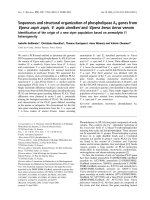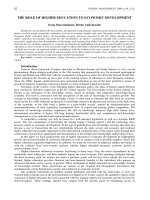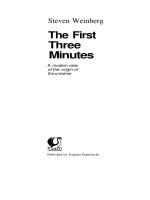the origin of higher clades
Bạn đang xem bản rút gọn của tài liệu. Xem và tải ngay bản đầy đủ của tài liệu tại đây (8.93 MB, 396 trang )
The Origin of Higher Clades
Osteology, Myology, Phylogeny and Evolution of
Bony Fishes and the Rise of Tetrapods
MONITORING AND EVALUATION OF
SOIL CONSERVATION AND
WATERSHED DEVELOPMENT PROJECTS
Rui Diogo
Department of Anthropology
The George Washington University
Washington, DC
USA
Science Publishers
Enfield (NH) Jersey Plymouth
The Origin of Higher Clades
Osteology, Myology, Phylogeny and Evolution of
Bony Fishes and the Rise of Tetrapods
SCIENCE PUBLISHERS
An imprint of Edenbridge Ltd., British Isles.
Post Office Box 699
Enfield, New Hampshire 03748
United States of America
Website:
(marketing department)
(editorial department)
(for all other enquiries)
Library of Congress Cataloging-in-Publication Data
Diogo, Rui
The origin of higher clades: osteology, myology, phylogeny, and evolution of bony fishes
and the rise of tetrapods/Rui Diogo.
p. cm.
Includes bibliographical references and index.
ISBN 978-1-57808-530-9 (Paperback)
1. Osteichthyes Evolution. I. Title.
QL618.2D56 2007
597.13’8 dc22
2007028539
ISBN 978-1-57808-530-9 (Paperback)
ISBN 978-1-57808-437-1 (Hardcover)
© 2007, Copyright reserved
Paperback edition 2008
All rights reserved. No part of this publication may be reproduced, stored in
a retrieval system, or transmitted in any form or by any means, electronic,
mechanical, photocopying, recording or otherwise, without the prior
permission.
This book is sold subject to the condition that it shall not, by way of trade or
otherwise, be lent, re-sold, hired out, or otherwise circulated without the
publisher’s prior consent in any form of binding or cover other than that in
which it is published and without a similar condition including this
condition being imposed on the subsequent purchaser.
Published by Science Publishers, Enfield, NH, USA
An imprint of Edenbridge Ltd.
Printed in India.
The Osteichthyes, including bony fishes and tetrapods, is a highly speciose
group of animals, comprising more than 42000 living species. The extraordi-
nary taxonomic diversity of osteichthyans is associated with a remarkable
variety of morphological features and adaptations to very different habitats,
from the deep-sea to high mountains. Osteichthyans therefore provide a very
interesting case study to analyze the origin and morphological macroevolu-
tion of higher-clades. In this book, I provide a new insight on the osteology,
myology, phylogeny and evolution of this fascinating group, which is based
on my own research and on a survey of the literature. Chapters 1 and 2
provide a short introduction to the main aims of the book and to the method-
ology and methods used. Chapter 3 deals with an extensive cladistic
analysis of osteichthyan higher-level interrelationships based on a phyloge-
netic comparison of 356 characters in 80 extant and fossil terminal taxa
representing all major groups of Osteichthyes. This cladistic analysis in-
cludes various terminal taxa and osteological characters, and namely a
large number of myological characters, not included in previous analyses.
Chapter 4 provides a general discussion on issues such as the comparative
anatomy, homologies and evolution of osteichthyan cranial and pectoral
muscles, the development of zebrafish cephalic muscles and the implica-
tions for evolutionary developmental studies, the origin, homologies and
evolution of one of the most peculiar and enigmatic structural complexes of
osteichthyans, the Weberian apparatus, and the use of myological versus
osteological characters in phylogenetic reconstructions. I hope that this
work may stimulate, and pave the way for, future studies on the comparative
anatomy, functional morphology, phylogeny and evolution of osteichthyans
and of vertebrates in general, which, as stressed throughout the book,
should ideally take into account the precious information obtained from the
study of muscular features.
Dedicated to MICHEL CHARDON, to his outstanding knowledge, to his
friendship, and to his humbleness
Preface
MONITORING AND EVALUATION OF
SOIL CONSERVATION AND
WATERSHED DEVELOPMENT PROJECTS
LEE
First of all, I want to thank P. Vandewalle and M. Chardon for accepting me
in the Laboratory of Functional and Evolutionary Morphology in 1998 and
thus for giving me the opportunity to begin my research on the anatomy,
functional morphology, phylogeny and evolution of vertebrates and of bony
fishes in particular. I also want to thank E. Parmentier. His persistence, the
remarkable ability that he has to solve all types of challenges, and the
courage he has to get deeply involved in different scientific areas were really
inspiring for me.
I am also thankful to R. Vari, as well as his colleagues S. Weitzman, J.
Williams and S. Jewett from the National Museum of Natural History, for
accepting me in that amazing museum during two academic years and for
providing numerous specimens analyzed in this work. I also want to thank
I Doadrio, who received me in the Museo Nacional de Ciencias Naturales
de Madrid, and has made available many specimens of the vast fish
collection of this museum, which is mainly the fruit of his hard work.
Another bright scientist who received me in his lab for several months was S.
Hughes, whom I thank very, very much. In his lab, at the prestigious MRC
Centre for Developmental Neurobiology of the King’s College of London, I
took my first steps in Evolutionary Developmental Biology (“Evo-Devo”). I
enjoyed much his availability, his interest, and his continuous questioning
and curiosity. I also want to take this occasion to thank B. Wood for inviting
me to continue my research at the Anthropology Department of the George
Washington University, where I shall have the opportunity to expand my
work to other osteichthyan groups, and particularly to primates.
A special thanks to the late G. Teugels, as well to J. Snoeks and E. Vreven
(Musée Royal de l’Afrique Centrale), P. Laleyé (Université Nationale du
Bénin), Z. Peng and S. He (Academy of Sciences of China at Wuhan), T.
Grande (Field Museum of Natural History), D. Catania (California Academy
of Sciences), M. Stiassny (American Museum of Natural History), M. Sabaj
Acknowledgements
LEEE
and J. Lundberg (Academy of Natural Sciences of Philadelphia), W. Fink, D.
Nelson and H. Ng (Museum of Zoology, University of Michigan), R. Bills
and P. Skelton (South African Institute for Aquatic Biodiversity), L. Page and
M. Retzer (Illinois Natural History Survey), P. Pruvost and G. Duhamel
(Museum National d’Histoire Naturelle) and R. Walsh and F. Slaby (George
Washington University) for kindly providing a large part of the specimens
analyzed. I also want to acknowledge T. Abreu, A. Zanata, F. Meunier, D.
Adriaens, F. Wagemans, M. de Pinna, P. Skelton, F. Poyato-Ariza, T. Grande,
H. Gebhardt, M. Ebach, A. Wyss, J. Waters, G. Cuny, L. Cavin, F. Santini, J.
Briggs, L. Gahagan, M. Gayet, J. Alves-Gomes, G. Lecointre, L. Soares-Porto,
P. Bockmann, B. Hall, F. Galis, T. Roberts, G. Arratia, L. Taverne, E. Trajano, C.
Ferraris, M. Brito, R. Reis, R. Winterbottom, C. Borden, B. Richmond and
many other colleagues for their helpful advice and assistance and for their
discussions on osteichthyan anatomy, functional morphology, phylogeny
and/or evolution in the last years. A special thanks to V. Abdala, with whom
I have discussed many of the parts of this work, and with whom I hope to
undertake the numerous projects we have in mind concerning vertebrate
musculature, as well as to J. Joss (Macquarie University) and A. Gosztonyi
(Centro Nacional Patagónico) for providing me the large dipnoan
specimens analyzed, and to J. Fernández and other people from the Museo
Nacional de Ciencias Naturales de Madrid for providing me the nice
salamander and lizard specimens examined.
My special thanks to all my friends, particularly to Pedro Brito, Claudia
Oliveira, Henry Evrard and Diego Alarcon Reina. Thank you very much,
Alejandrita Pelito Lindo, and thanks to our amazing and adorable Tots
Pelluda. Very special thanks to my parents, Valter and Fatima, to my
brothers, Hugo and Luis, and to my late grandfathers Raul and Amélia.
Thank you very much for the confidence in my work and for the close
cooperation in the several projects we have together. Finally, thanks to all
those who have been involved in administering the various grants and other
awards that I received during the last years, without which this work would
really not have been possible.
EN
II, III, IV, V, VII, IIX, IX, X foramens/nerves of Miles’s 1977 original
drawing
A0, A1, A1-OST adductor mandibulae A0, A1 and A1-OST
A1-OST-L, A1-OST-M lateral and mesial sections of adductor
mandibulae A1-OST
A2 adductor mandibulae A2
A2-D, A2-PVM, A2-V dorsal, posteroventromesial and ventral
sections of adductor mandibulae
A3', A3'’ adductor mandibulae A3' and A3'’
AB-PRO abductor profundus
AB-SUP abductor superficialis
abs anterior bulla of swimbladder
AC anconaeus coracoideus
AD-AP adductor arcus palatini
AD-HYO adductor hyomandibulae
AD-OP adductor operculi
AD-PRO adductor profundus
AD-SUP adductor superficialis
ADM adductor mandibulae
AED1 abductor et extensor digiti I
AHL, AHM anconaeus humeralis lateralis and medialis
am ampulla
am-m macula of ampulla
AME adductor mandibulae externus
ana anterior neural arch
ang angular
List of Abbreviations*
*Myological structures are shown in bold
N
angart anguloarticular
angrart anguloretroarticular
anocl anocleithrum
aorb groove and foramen for orbital artery of Miles,
1977
apal autopalatine
ar-chp articulatory area for posterior ceratohyal
ar-hm articulatory area for hyomandibula
ar-mnd articulatory area for mandible
ar-neu articulatory area for neurocranium
ar-op articulatory area for opercular bone
ar-pq articulatory area for palatoquadrate
ar-q articulatory area for quadrate
ar-sym articulatory area for symplectic
ARR-3 arrector 3
ARR-D arrector dorsalis
ARR-D-1,2 sections of arrector dorsalis
ARR-V arrector ventralis
ARR-V-1,2 sections of arrector ventralis
art articular
artrart articuloretroarticular
asi atria sinus imparis
ASM anconaeus scapularis medialis
atpm anterior transversal peritoneal membrane
AW, A
ww
ww
w adductor mandibulae A
ww
ww
w
AW-D, AW-V bundles of adductor mandibulae A
ww
ww
w
b cranial bone B of Miles, 1977
bb basibranchial
BC basicranial muscle
BH branchiohyoideus
BM branchiomandibularis
boc basioccipital
boc-phapr pharyngeal process of basioccipital
BRM branchial muscles
bsph basisphenoid
C cucullaris
c-apal-eth cartilage between autopalatine and ethmoid
region
NE
c-eth ethmoid cartilage
c-ia interatrial cartilage
c-mapa cartilage between maxilla and autopalatine
and/or dermopalatine
c-Meck Meckel’s cartilage
c-peth pre-ethmoid cartilage
cam camera aerea Weberiana
can anterior semicircular canal
cart cartilage
cb1 ceratobranchial 1
CBL coracobrachialis longus
cc complex centrum
CCL contrahentium caput longum
CCO constrictor colli
cctr canalis communicans transversus
CD contrahentes digitorum
CEH ceratohyoideus
CERV cervicomandibularis
ch, ch-a, ch-p ceratohyal, anterior ceratohyal and posterior
ceratohyal
cho horizontal semicircular canal
cl cleithrum
cl-hp humeral process of cleithrum
cla claustrum
clav clavicle
CM coracomandibularis
co concha of scaphium
com coronomeckelian bone
COP constrictor operculi
cor coracoid
cor-vmp ventromesial process of coracoid
CORAD coracoradialis
coro coronoid bone
crb cranial rib
CRB-PECG muscle between cranial rib and pectoral
girdle
cus utriculo-saccular canal
dI, dII, dIII, dIV, dV digits I, II, III, IV and V
NEE
den dentary bone
den-alp anterolateral process of dentary bone
df deep fossa
DIL-OP dilatator operculi
DM depressor mandibulae
DM-A, DM-P anterior and posterior parts of depressor
mandibulae
dmtte dorsomesial area of thin tunica externa
(“median slit”)
dpal dermopalatine
DS dorsalis scapulae
dsph dermosphenotic
EACR extensor antebrachii et carpi radialis
EACU extensor antebrachii et carpi ulnaris
ECR extensor carpi radialis
ect ectopterygoid
ECU extensor carpi radialis
EDB extensores digitorum breves
EDC extensor digitorum communis
EDL extensor digitorum longus
ehy epihyal
ELD4 extensor lateralis digiti IV
ent entopterygoid
EP epaxialis
EPIST episternocleidomastoideus
EPITR epitrochleoanconeus
epoc epioccipital
et epipterygoid
exoc exoccipital
exs extrascapular
extracl extracleithrum
f cranial bone F of Miles, 1977
FACR flexor antebrachii et carpi radialis
FACU flexor antebrachii et carpi ulnaris
FAL flexor accessorius lateralis
FAM flexor accessorius medialis
FBP flexores breves profundi
FBS flexores breves superficiales
NEEE
FCR flexor carpi radialis
FDC flexor digitorum communis
FDL flexor digitorum longus
FLEP flexor plate
fr frontal
fte ichthyocoll fibers of tunica externa inserting
on transformator tripodis
GG genioglossus
GG-L, GG-M genioglossus lateralis and medialis
GH geniohyoideus
gplate gular plate
GT geniothoracicus
HAB humeroantebrachialis
hc hyoid cornu
HG hyoglossus
HH hyohyoideus
HH-AB hyohyoideus abductor
HH-AD hyohyoidei adductores
HH-INF hyohyoideus inferior
HH-SUP hyohyoideus inferior
hm hyomandibula
hum humerus
hyh, hyh-d, hyh-v hypohyal, dorsal hypohyal and ventral
hypohyal
HYP hypaxialis
i cranial bone I of Miles, 1977
iclav interclavicle
ih interhyal
IMC intermetacarpales
inc intercalarium
inc-ap, inc-asc articular and ascendens processes of
intercalarium
int intercalar
INTE interhyoideus
INTE-L, INTE-M lateral and mesial divisions of interhyoideus
INTM intermandibularis
INTM-A, INTM-P anterior and posterior bundles of
intermandibularis
NEL
iop interopercle
k-m cranial bone K-M of Miles, 1977
keth kinethmoid
j jugal
l-A, B, C, D, E, F, G ligaments A, B, C, D, E, F, G
l-ans anterior ligament of os suspensorium
l-Bau Baudelot’s ligament
l-ch-mnd ligament between ceratohyal and mandible
l-chp-mnd ligament between posterior ceratohyal and
mandible
l-cl-pecra1 ligament between cleithrum and pectoral ray 1
l-crb-scl ligament between cranial rib and
supracleithrum
l-ent-leth ligament between entopterygoid and lateral
ethmoid
l-hmsusp hyosuspensory ligament of Miles, 1977
l-in intercostal (intervertebral) ligament
l-io interossicular ligament
l-iop-mnd ligament between interopercle and mandible
l-meth-apal ligament between mesethmoid and
autopalatine
l-meth-prmx ligament between mesethmoid and premaxilla
l-mx-mx ligament between the two maxillae
l-pop-mnd ligament between preopercle and mandible
l-post-epoc ligament between posttemporal and
epioccipital
l-post-epoc-1, 2 ligaments 1 and 2 between posttemporal and
epioccipital
l-post-neupos ligament between posttemporal and posterior
margin of neurocranium
l-pri primordial ligament
l-prmx-apal ligament between premaxilla and autopalatine
l-rbr-mnd ligament between branchiostegal rays and
mandible
l-s suspensor ligament
l-susp-neur ligament between suspensorium and
neurocranium
LA labial muscle
lab labyrinth
NL
lac lacrimal
lag lagena
lagcap lagenar capsule
lca lateral cutaneous area
LD latissimus dorsi
leth lateral ethmoid
LEV-5 levator arcus branchialis V
LEV-AO levator anguli oris
LEV-AP levator arcus palatini
LEV-AP-1, LEV-AP-2 sections of levator arcus palatini
LEV-H levator hyoideus
LEV-HYO levator hyomandibulae
LEV-OP levator operculi
LMS3, LMS4 levator maxillae superioris 3 and 4
mcor-ar mesocoracoid arch
ment mentomeckelian bone
mesopte mesopterygium
metapte metapterygium
meth mesethmoid
MH mandibulohyoideus
mnd mandible
mp metapterygoid
mx maxilla
mx-b maxillary barbel
n nasal
na neural arch
na1, 2, 3, 4, 5 neural arches 1, 2, 3, 4, 5
na3-adp anterodorsal process of neural arch 3
naoc occipital neural arch
neu neurocranium
nsp neural spine
OH omohyoideus
OM ocular muscles
op opercular bone
opcart opercular cartilage
OPE opercularis
opmem opercular membrane
osph orbitosphenoid
NLE
osus os suspensorium
ot-oc otic-occipital
P pectoralis
pa parietal
pa-exs parieto-extrascapular
PAC pronator accessorius
pal palatine
palm-ses palmar sesamoid
paq palatoquadrate
para parasphenoid
part prearticular
PCH procoracohumeralis
pcl postcleithrum
pe perilymphatic space
pec-fin pectoral fin
pec-ra pectoral rays
pec-ra-1, 2 pectoral rays 1, 2
pec-splint pectoral splint
pif pineal foramen
PM-MA, PM-MI palatomandibularis major and minor
po postorbital
po-ch posterior (“hydrostatic”) chamber of the
swimbladder
pof postfrontal
pop preopercle
post posttemporal
pp parapophysis
pp1, 2, 3, 4, 5 parapophyses of vertebrae 1, 2, 3, 4, 5
PPR pronator profundus
PR-H protractor hyoidei
PR-H-D, PR-H-V ventral and dorsal sections of protractor
hyoidei
PR-MUP protractor of “Müllerian” process
PR-PEC protractor pectoralis
PR-PM protractor hyomandibulae
pra proximal radial
prf prefrontal
prmx premaxilla
NLEE
propte propterygium
prot prootic
ps perilymphatic space
PSE-SUP pseudotemporalis superficialis
psp postsplenial
psph pterosphenoid
pt pterotic
pte pterygoid
PTM pterygomandibularis
PTR pronator teres
pvm prevomer
pvm-tlp prevomeral tooth plate
q quadrate
qju quadratojugal
r-br branchiostegal rays
r-br-I, II, IV branchiostegal rays I, II, IV
rad radius
rart retroarticular
RC rectus cervicis
RE-AO retractor anguli oris
RE-HM retractor hyomandibulae
rib3, 4, 5 rib of vertebrae 3, 4, 5
rm-mb mesial branch of ramus mandibularis
rsph rhinosphenoid
S1, S2, S3, S4, S5 “supinator muscles” of Millot and Anthony,
1958
sa saccule
SAR1 subarcualis rectus 1
sate supple area of tunica externa
sb swimbladder
sc scaphium
sc-ap, sc-asc articular and ascendens processes of
scaphium
sca scapula
sca-cor scapulo-coracoid
scl supracleithrum
SCO supracoracoideus
sdo supradorsal
NLEEE
se sinus endolymphaticus
sem septomaxilla
sepl, sept longitudinal and transversal septa of the
swimbladder
SH sternohyoideus
SH-PRO, SH-SUP sternohyoideus profundus and superficialis
smx supramaxilla
sne supraneural
sne1, 2, 3 supraneurals 1, 2, 3
soc supraoccipital
sop subopercular bone
sopcart subopercular cartilage
sp splenial bone
spe sphenethmoid
sph sphenotic
sppsp splenialpostsplenial
spv saccus paraventralis
sq squamosal
st supratemporal
stp stapes
sucom supratemporal commissure
sura surangular
sym symplectic
T-A1,T-A2 tendons of adductor mandibulae A1 and A2
T-AW-V tendon of adductor mandibulae A
ww
ww
w-V
T-FDL tendons of flexor digitorum longus
T-SH tendons of sternohyoideus
tab tabular
te tunica externa of swimbladder
tf transformator tripodis
tri tripus
tri-ap articular process of tripus
u utricle
uh urohyal
ul ulna
v1, 2, 3, 4, 5 vertebrae 1, 2, 3, 4, 5
vm vomer
x cranial bone X of Miles, 1977
y1+y2 cranial bone Y1+Y2 of Miles, 1977
NEN
Preface v
Acknowledgements vii
List of Abbreviations ix
1. Introduction and Aims 1
2. Methodology and Material 10
3. Phylogenetic Analysis 19
3.1 Cladistic Analysis, Diagnosis for Clades Obtained, and
Comparison with Previous Hypotheses 19
4. Comparative Anatomy, Higher-level Phylogeny and
Macroevolution of Osteichthyans—A Discussion 224
4.1 Brief Summary of the Phylogenetic
Results Obtained in the Cladistic Analysis 225
4.2 Comparative Anatomy, Homologies, and
Evolution of Osteichthyan Cranial Muscles 227
4.3 Cranial Muscles, Zebrafish, and Evolutionary
Developmental Biology 264
4.4 Comparative Anatomy, Homologies and Evolution of
Osteichthyan Pectoral Muscles 276
4.5 Origin, Homologies and Evolution of
the Weberian Apparatus 288
4.6 Myological versus Osteological Characters in
Phylogenetic Reconstructions: A New Insight 310
References 326
Plates 1-7 between 362-363
Index 363
Contents
MONITORING AND EVALUATION OF
SOIL CONSERVATION AND
WATERSHED DEVELOPMENT PROJECTS
T
he Osteichthyes, including bony fishes and tetrapods, is a highly
speciose group of animals comprising more than 42,000 living species.
Two main osteichthyan groups are usually recognized: the Sarcopterygii
(lobefins and tetrapods), with an estimate of more than 24,000 living species
(e.g., Stiassny et al., 2004), and the Actinopterygii (rayfins), including more
than 28,000 extant species (e.g., Nelson, 2006). The extraordinary taxonomic
diversity of osteichthyans is associated with a remarkable variety of
morphological features and adaptations to very different habitats, from the
deep sea to high mountains. In this brief Introduction, I will not provide a
detailed historical account of all the numerous works dealing with
osteichthyan phylogeny. Such information can be found in overviews such
as Arratia (2000: relationships among major teleostean groups), Clack (2002:
relationships among major groups of early tetrapods), Stiassny et al. (2004:
relationships among major groups of gnathostome fishes), Cloutier and
Arratia (2004: relationships among early actinopterygians), and Nelson
(2006: relationships among numerous fish groups). I prefer simply to give
the reader a general idea of the phylogenetic scenario that is nowadays most
commonly accepted in textbooks concerning the relationships between the
major osteichthyan groups, which is shown in Fig. 1. Further details about
this subject will be given in Chapter 3, in which I will discuss each of these
groups separately and compare the phylogenetic results obtained in this
work with those of previous studies.
The extant vertebrates that are usually considered to be the closest
relatives of osteichthyans are the chondrichthyans (Fig. 1). However, it
should be stressed that according to most authors there is a group of fossil
fishes that is even more closely related to osteichthyans: the †Acanthodii,
which, together with the Osteichthyes, form a group usually named
Teleostomi (e.g., Kardong, 2002). In addition, it should be noted that apart
from the Teleostomi and Chondrichthyes, there is another group that is
Introduction and Aims
Chapter
1
Figure 1. Relationships between the major extant gnathostome groups, modified
from Stiassny et al. (2004); past and present counts of nominal families by column
width through time (numbers are millions of years; tetrapod diversity truncated,
chondrichthyan diversity truncated to the left and acanthomorph diversity
truncated to the right); familial diversity is charted and this does not necessarily
reflect known species diversity (for more details, see text).
usually included in the gnathostomes and that is usually considered the
sister-group of teleostomes + chondrichthyans: the †Placodermi (e.g.,
Kardong, 2002). There are only two groups of extant sarcopterygian fishes,
Ostariophysi
!
the coelacanths (Actinistia) and lungfishes (Dipnoi) (Fig. 1). The
Polypteridae (included in the Cladistia) are commonly considered the most
basal extant actinopterygian taxon (Fig. 1). The Acipenseridae and
Polyodontidae (included in the Chondrostei) are usually considered the
sister-group of a clade including the Lepisosteidae (included in the
Ginglymodi) and the Amiidae (included in Halecomorphi) plus the
Teleostei (Fig. 1). Regarding the Teleostei, four main living clades are usually
recognized in recent works: the Elopomorpha, Osteoglossomorpha,
Otocephala (Clupeomorpha + Ostariophysi) and Euteleostei (Fig. 1).
In order to provide more detail on the various subgroups of these four
teleostean clades, I will refer to a cladogram provided by Springer and
Johnson (2004), which, in my opinion, adequately summarizes the scenario
that is probably accepted by most researchers nowadays. A simplified
version of this cladogram is shown in Fig. 2. As can be seen, among these
four teleostean groups the Osteoglossomorpha appears as the most basal
one, the Elopomorpha appearing as the sister-group of Otocephala +
Euteleostei (Fig. 2). Within the Euteleostei, the Esociformes are placed closely
related to the Neoteleostei, although many authors consider the esociforms
as part of the “Protacanthopterygii” (see below). Other fishes usually
included in the “Protacanthopterygii” are the Alepocephaloidea, the
Argentinoidea, the Salmoniformes, the Osmeroidea, and the Galaxioidea.
As stressed by Springer and Johnson (2004) and Stiassny et al. (2004), on
whose works Figs. 1 and 2 are based, although the scenarios shown in those
figures are widely accepted nowadays, they are far from being agreed upon
by all specialists. For instance, Filleul (2000) and Filleul and Lavoué (2001)
argued that the Elopomorpha is in fact not a monophyletic unit. Ishiguro et
al. (2003) and other authors maintained that the Otocephala, as currently
recognized (Ostariophysi + Clupeomorpha), is also not monophyletic, since
certain otocephalans are more closely related to the “protacanthopterygian”
alepocephaloids than to other otocephalans. Also, contrary to what is
accepted by most authors (Fig. 2), Ishiguro et al. (2003) suggested that the
non-alepocephaloid “protacanthopterygians” (sensu these authors, that is,
the Esociformes, Salmoniformes, Osmeriformes and Argentinoidea) form a
monophyletic, valid “Protacanthopterygii” clade. To give another example,
Arratia (1997, 1999) argued that the most basal extant teleostean group is the
Elopomorpha, and not the Osteoglossomorpha, as shown in Fig. 2. In fact, as
can be seen in Fig. 1, in contrast with Springer and Johnson (2004), Stiassny
et al. (2004) opted to place the Osteoglossomorpha, Elopomorpha and
remaining teleosts in an unresolved trichotomy. And, as can also be seen in
that figure, this is not the only trichotomy appearing in Stiassny et al.’s
(2004) cladogram.
"
Figure 2 Relationships between the major extant teleostean groups, modified
from Springer and Johnson (2004); the “protacanthopterygian” groups shown in
the tree correspond to those of Ishiguro et al. (2003) (for more details, see text).
The other trichotomy appearing in that cladogram concerns one of the
most discussed topics in osteichthyan phylogeny: that concerning the
identity of the closest living relatives of the Tetrapoda (Fig. 1). This topic has
been, and continues to be, the subject of much controversy. In general
textbooks such as those by Lecointre and Le Guyader (2001), Kardong (2002)
and Dawkins (2004), the tetrapods often appear more closely related to
lungfishes than to the coelacanths. This view has been defended, at least
partly, in many morphological and molecular works, such as those by Rosen
et al. (1981), Patterson (1981), Forey (1980, 1991), Cloutier and Ahlberg
(1996), Zardoya et al. (1998), Meyer and Zardoya (2003), and Brinkmann et
al. (2004). However, researchers such as Zhu and Schultze (1997, 2001), on
the basis of anatomical studies, defended a closer relationship between
Ctenosquamata
Aulopiformes
Ateleopodiformes
Stomiiformes
Esociformes
Alepocephaloidea
Argentinoidea
Osmeroidea
Galaxioidea
Salmoniformes
Gymnotiformes
Siluriformes
Characiformes
Cypriniformes
Gonorynchiformes
Clupeoidea
Engrauloidea
Pristigasteroidea
Denticipitoidei
Anguilliformes
Saccopharyngiformes
Notacanthiformes
Albuliformes
Elopiformes
Osteoglossiformes
Hiodontiformes
OSTEOGLOSSOMORPHA
ELOPOMORPHA
CLUPEOMORPHA
OSTARIOPHYSI
OTOPHYSI
ELOPOCEPHALA
CLUPEOCEPHALA
OTOCEPHALA
EUTELEOSTEI
NEOTELEOSTEI
‘PROTACANTHOPTERYGII’
‘PROTACANTHOPTERYGII’
Argentiniformes
Osmeriformes
TELEOSTEI









